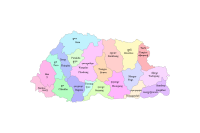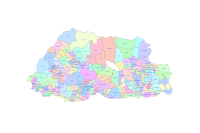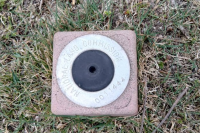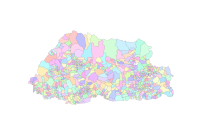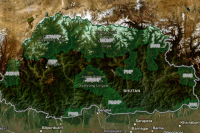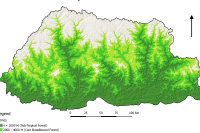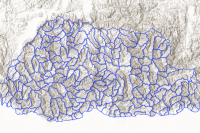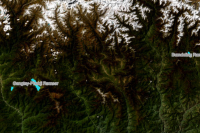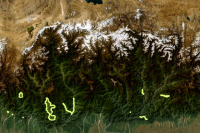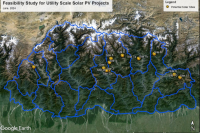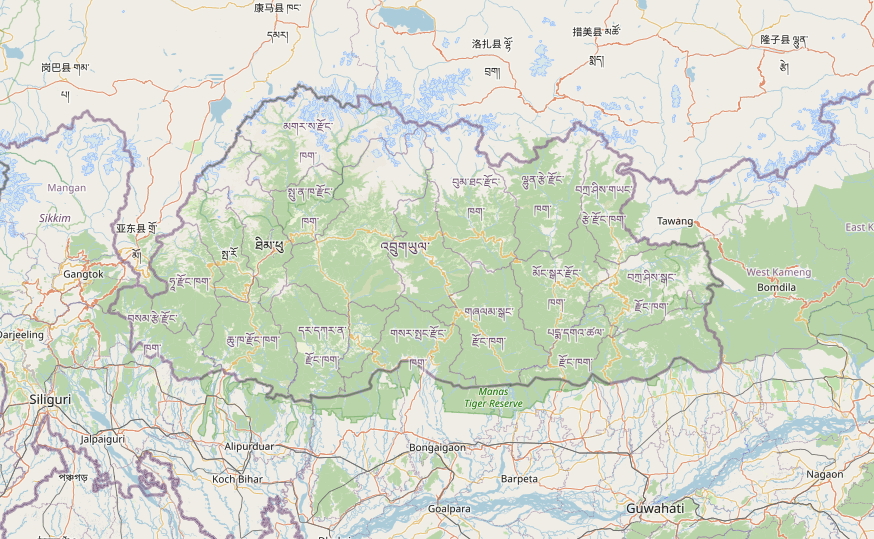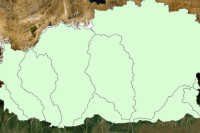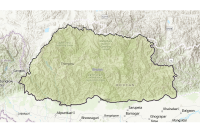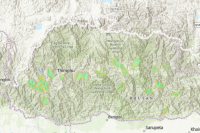Boundaries
National Land Commission Secretariat
Dzongkhag Boundary Category: Open
The District boundaries of Bhutan are delineated from Topographic maps based on the endorsed administrative boundary descriptions and high-resolution satellite images.
Keywords: [#dzongkhag#area]
National Land Commission Secretariat
Gewog Boundary Category: Open
Gewog boundaries are the block boundaries dividing the districts into several blocks .The data is derived from Topographic maps.
Keywords: [#gewog boundary#gewog area]
National Land Commission Secretariat
GPS Stations (Second Order) Category: Open
The Secondary Station Control Coordinates are established by means of GNSS observation data for a duration of 1 to 3 hour. These coordinates are processed and adjusted by Total Trimble Control Software (TTC). The accuracy of the coordinates has been achieved at reasonable level for mapping specifications or standards of 10 cm cadastral tolerances.
Keywords: [#control point#secondary control#coordinates#benchmark]
National Land Commission Secretariat
Chiwog Boundary Category: Open
Chiwog boundaries divide the block, Gewog, into several groups of villages for administration. The Chiwog boundaries were delineated during the local government election in 2010
Keywords: [#dzongkhag#gewog#area#population#chiwog boundary]
Department of Forests and Park Services
Biological Corridor Category: Common
Biological Corridors (BC) are areas set aside to connect one or more Protected Areas (PA) and facilitate free movement of wild animals which will facilitate long term conservation of wildlife population of wide range of species, promote gene flow and enable species to adapt to climate change impacts.
Keywords: [#biological corridor#area#park]
Department of Forests and Park Services
Conservation Parks Category: Common
Conservation parks are geographical areas which are declared as National Park (NP), Wildlife Sanctuary (WS), Strict Nature Reserve (SNR) or any conservation area declared by the parliament of Bhutan and dedicated and managed to achieve the long term goal of conservation of nature with associated ecosystem services and sociocultural values.
Keywords: [#conservation#park#area]
Department of Forests and Park Services
Land Use Land Cover 2016 Category: Common
The LULC (2016) land cover assessment shows a national forest cover of 70.77% (excluding shrubs), of which 45.94% is Broadleaf, 13.53% is Mixed Conifer, 6.02% is Fir, 2.64% is Chir pine and 2.64% is Blue pine. The Alpine Scrub is 3.39%, Shrubs constitute 9.74%, while cultivated agricultural land and meadows account for 2.75% and 2.51% respectively. The snow cover constitutes 5.35% and rocky outcrops 4.15% while water bodies, built up areas, non-built up areas, landslides and moraines constitute less than 1% each
Keywords: [#land use#land cover#settlement#road#water#snow#vegetation#agriculture#forest#grassland]
Department of Water
186 Watershed boundary Category: Open
Bhutan is divided into 186 watersheds.
Keywords: [#watershed#area]
Department of Forests and Park Services
Ramsar Site Category: Common
Ramsar sites are wetlands of international importance. Wetlands include rivers, streams and springs with associated riverine and riparian zones; lake, pond, swamp, marsh, fen and peatland with water that is static or flowing with distinct floral and faunal communities. Wetlands provide fundamental ecosystem services, such as water regulation, filtration and purification, as well as numerous scientific, cultural and recreational values. Wetlands are important for maintenance of the broader ecosystem's health.
Keywords: [#watershed#ramsar]
Department of Forests and Park Services
Key Biodiversity Area Category: Common
The KBA are “sites contributing significantly to the global persistence of biodiversity” (IUCN, 2016). In the context of Bhutan, the word ‘global’ in this definition may be replaced with ‘national’ when deemed necessary, and “sites” shall refer to “areas outside protected areas”. As such, KBA are “sites outside protected area networks, contributing significantly to the global and/or national persistence of biodiversity”
Keywords: [#biodiversity#area]
Department of Energy
Potential Solar Sites Category: Restricted
This data provides the potential utility scale solar PV sites in Bhutan
Keywords: [#Solar Sites#Renewable Energy#Energy]
Department of Water
Potential Recharge Area view Category: Common
Land Area in which water percolates through soil to recharge under aquifers that forms marsh, fen, bog, peatland or water, whether natural or artificial, permanent or temporary, with water that is static or flowing, fresh or brackish, including snow and glaciers
Keywords: [#groundwater#hydrology]
Department of Water
Basin boundary Category: Open
Bhutan has an extensive river system that is generally distinguished by main rivers that flow north to south. The main rivers are Amochhu,Wangchhu, Punatsangchhu,and Manas. Manas is made up of Mangdechhu and Dragmechhu. For the purpose of management, Mangdechhu and Drangmechhu shall be considered as two separate basins. Amochhu and Drangmechhu originates in China.There are smaller rivers namely, Jaldakha, Aiechhu, Nyera-Amari, Jomori and Merak-Sakteng.
Keywords: [#basin#boundary#area]
Department of Geology and Mines
Geologic Map of Bhutan Category: Open
Featured in the Journal of Maps in 2011, this geological map presents a newly compiled 1:500,000-scale representation of Bhutan, along with neighboring areas in India and southern Tibet. Assembled from the most recent and comprehensive mapping datasets available at the time, it offers a significantly enhanced level of structural detail compared to earlier geological maps of the region. Bhutan’s geology is broadly categorized into four major lithological units, arranged from south to north: the Siwalik Group, the Lesser Himalayan Zone, the Greater Himalayan Zone, and the Tethyan Himalayan Zone. Alongside this, the antiformal tectonic window exposing Lesser Himalayan units with the Greater Himalaya, and the synformal klippe of Tethyan Himalayan units—both regarded as characteristic structural features of the Himalayas are also mapped in the Bhutanese Himalaya.
Department of Forests and Park Services
Community Forests Category: Common
Community Forests (CF) are any area of State Reserved Forest Land (SRFL) designated for management by a local community. The Department facilitates establishment of Community Forest to encourage sustainable management of trees and non-wood forest produce by the community to derive socio-economic and environmental benefit.
Keywords: []
Department of Forests and Park Services
Forest Management Units Category: Common
Forest Management Units (FMU) are designated State Reserved Forest Land (SRFL) managed as production forests under an approved Management Plan primarily for production of timber, firewood, and other forest produce.
Keywords: []
